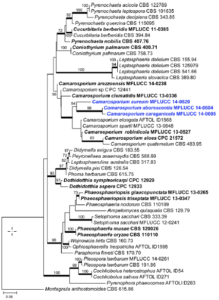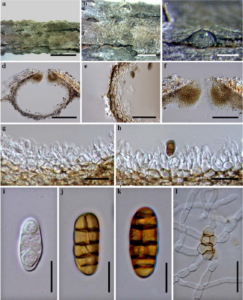Camarosporium aureum Norphanphoun, Bulgakov & K.D. Hyde.
Index Fungorum number: IF550905, Facesoffungi Number: FoF 00551; Fig. 2
Etymology – From the Latin, aureum meaning gold, in reference to the colour nature of the conidia.
Holotype – MFLU 14–0770
Saprobic on dead herbaceous branches of Cotinus coggygria (Scop.). Sexual morph Undetermined. Asexual morph Conidiomata 400 – 550 μm high, 350 – 550 μm diam. pycnidial, solitary, immersed, unilocular, dark brown, with a central ostiole. Pycnidial wall 25 – 30 μm multi-layered, with 4 – 5 layers of brown, cells of textura angularis, with inner most layer thin, hyaline. Conidiophores reduced to conidiogenous cells. Conidiogenous cells enteroblastic, phialidic, hyaline, smooth, formed from the inner most layer of pycnidium wall. Conidia (19 – ) –19.5 – 22.5 (– 24) × 8 – 9 (– 10) μm (x̄ = 21 × 9.5 μm, n = 30) oblong, mostly straight, infrequently slightly curved, muriform, with 4 – 5 transverse septa, with 2 – 3 longitudinal septa, not constricted at the septa, initially hyaline, pale gold to brown at maturity, narrowly rounded at both ends, smooth-walled.
Culture characters – Colonies on PDA slow growing, reaching 2 cm diam. after 11 days at 25 °C, later producing dense mycelium, circular, margin rough, white at first, greenish-yellow after 5 days, flat or effuse on surface, without aerial mycelium. Hyphae septate branched, hyaline, thin.
Material examined – RUSSIA, Rostov region, Shakhty city, near Grushevsky pond, shelterbelt artificial forest, on dead branches of Cotinus coggygria Scop. (Anacardiaceae) 18 March.2014, T. Bulgakov (MFLU 14 – 0770, holotype); ibid. (PDD isotype); ex-type culture, MFLUCC 14–0620. GenBank ITS: KP744436; LSU: KP744478; SSU: KP753948.
Notes – Sutton (1980) reported the type species of Camarosporium, C. quaternatum from Lycium halimifolium, which was characterized by fusiform conidia, with 3 – 4 transverse septa, and several secondary longitudinal or oblique septa. Our new species has oblong, larger conidia and 4 – 5 transverse septa, with 2 – 3 longitudinal septa and is golden brown at maturity. Molecular phylogenetic analysis of combined ITS and LSU gene data places C. aureum close to C. spartii Trail from Cytisus sp. (Fig. 1). However, C. spartii has shorter and narrower conidia (13 – 16 × 6 – 7 μm).

Fig. 1 Phylogram generated from Maximum likelihood (RAxML) analysis based on combined LSU, SSU and ITS sequence data of Pleosporales. Maximum likelihood bootstrap support values greater than 50 % are indicated above or below the nodes, and branches with Bayesian posterior probabilities greater than 0.95 are given in bold. The ex-types (reference strains) are in bold; the new isolates are in blue. The tree is rooted with Montagnula anthostomoides CBS 615.86.

Fig. 2 Camarosporium aureum (holotype), a Stromatal habit in wood b, c Fruiting bodies on substrate d Cross section of the stroma showing perithecia e Peridium f Apex of perithecia g – h Conidiogenous cell with attached conidia i Immature conidia. j – k Mature conidia. l Germinating conidia. Scale bars: d = 200 μm, e = 50 μm, f = 100 μm, g – h = 20 μm, i – k = 10 μm, l = 30 μm.
